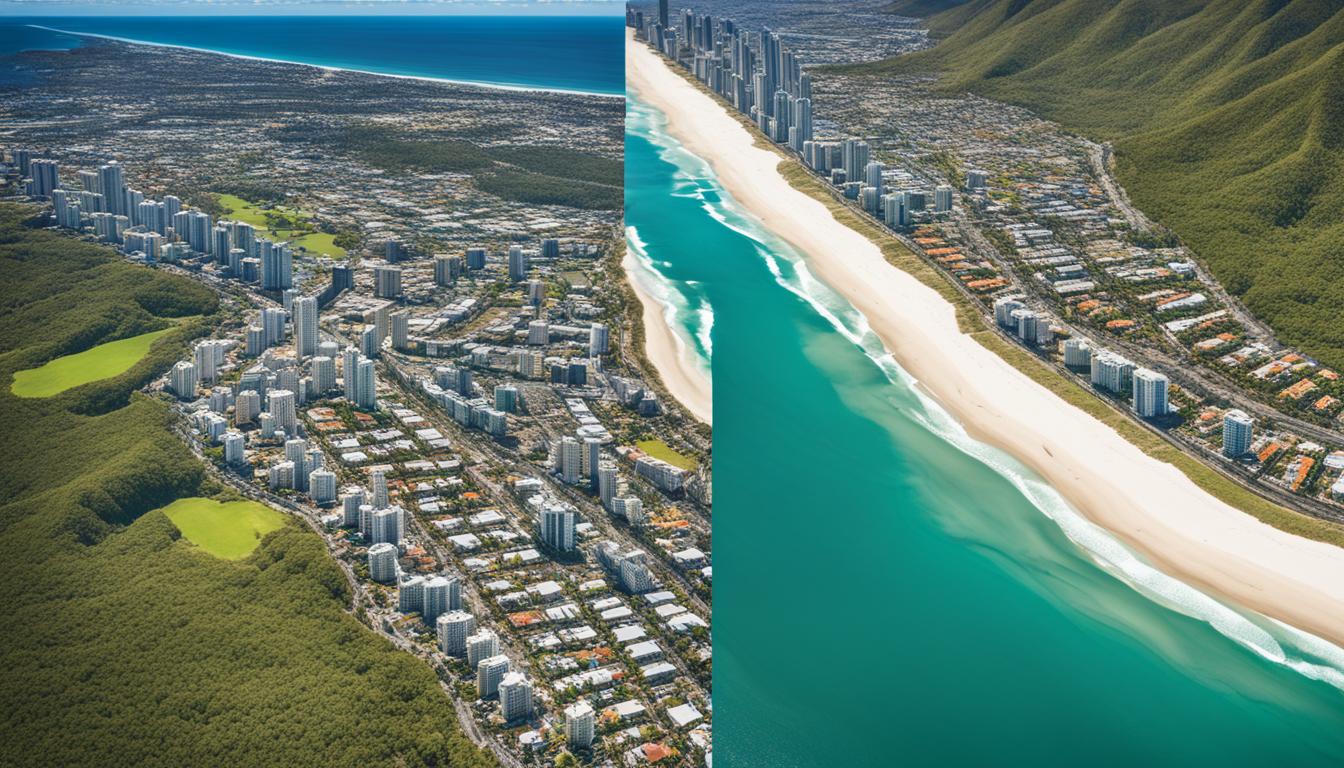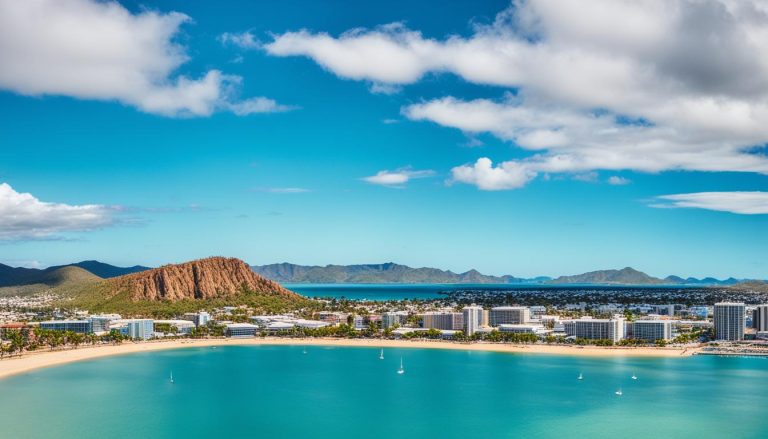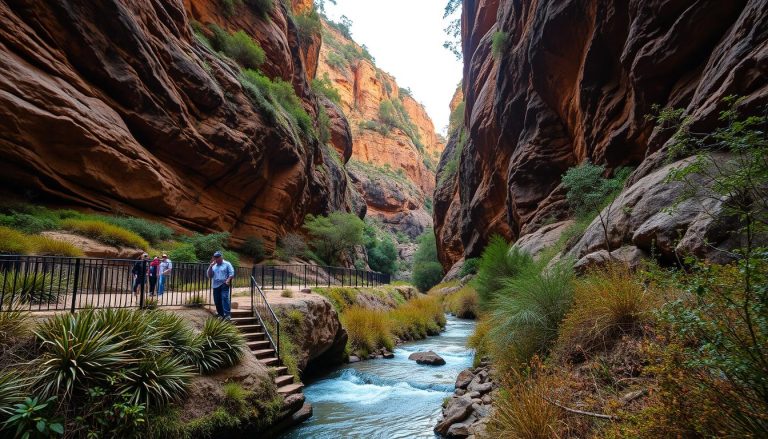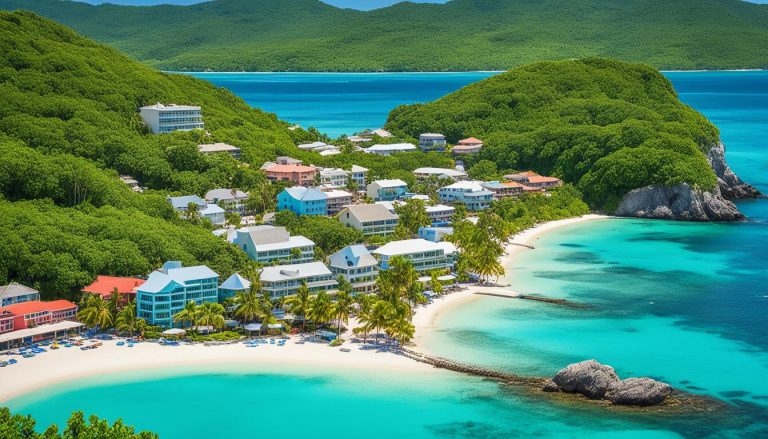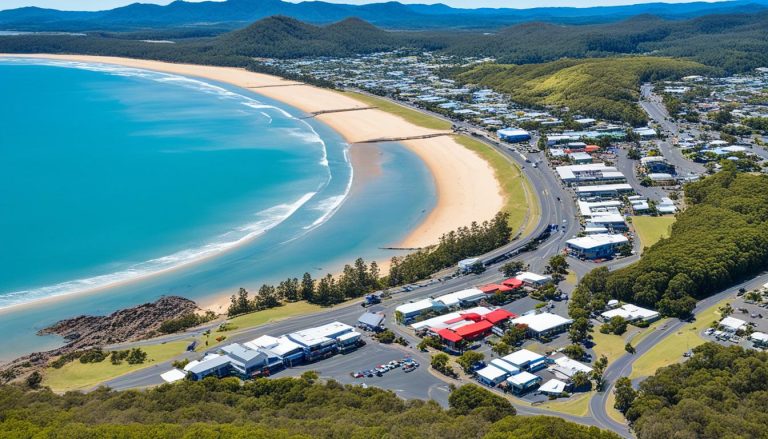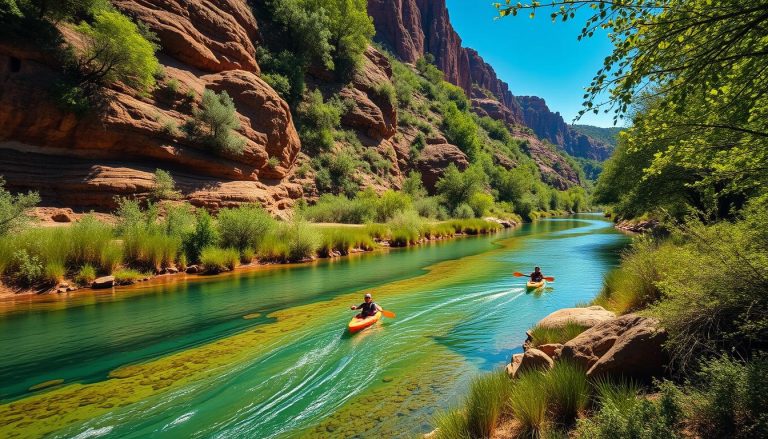Are you dreaming of a beach getaway in a sunny paradise? The Gold Coast is your perfect spot on Australia’s Sunshine Coast. But when is the best time to visit? Knowing the seasonal weather patterns is key to a great trip.
The Gold Coast is a top choice for many travelers. It’s known for its sunny weather and beautiful beaches. To enjoy it fully, plan your visit during the best months for good weather and fewer crowds.
Understanding Queensland's Subtropical Climate
Australia is huge and has many different climates. The north is hot and humid all year, while the south changes with the seasons. Queensland, especially around Brisbane, has a subtropical climate. This means it’s warm and sunny, perfect for beach lovers.
Seasonal Variations Across the Country
Seasons change a lot in Australia, depending on where you are. The north, like Queensland, is always warm and humid. The south has cold, wet winters and hot, dry summers.
Coastal vs. Interior Climate Patterns
The coast and the interior have different climates in Australia. The coast, like the Gold Coast in Queensland, is cooler and more temperate. This is because the ocean helps keep it mild. The interior is hotter and gets less rain because it’s far from the sea.
| Climate Characteristic | Coastal Regions | Interior Regions |
|---|---|---|
| Temperature | Cooler and more temperate | Hotter and more extreme |
| Rainfall | Higher precipitation levels | Lower rainfall and drier conditions |
| Humidity | More humid due to proximity to the ocean | Drier air due to distance from the coast |
Knowing about Australia’s different climates helps travelers plan trips to Queensland. They can enjoy the warm, sunny, and subtropical weather.
Gold Coast's Weather: A Beachgoer's Paradise
If you’re planning a beach vacation, the Gold Coast in Queensland, Australia is perfect. It has warm temperatures, little rain, and lots of sunshine. This makes it ideal for those who love the sun and water.
Temperature and Rainfall Patterns
The Gold Coast has a subtropical climate. Summers are warm, with highs around 84°F (29°C). Winters are mild, with lows around 50°F (10°C). The area gets little rain, mostly in summer, which can bring thunderstorms. This dry, warm climate makes it great for beach vacations all year.
Seasonal Humidity and Sunshine
Humidity changes with the seasons, peaking in February at 65-70%. Spring and fall are warm and breezy, perfect for being outside. The Gold Coast gets about 7 hours of sunshine daily. This means there’s plenty of time to enjoy the sun and the beaches.
| Month | Average High Temperature (°F) | Average Low Temperature (°F) | Average Rainfall (inches) | Average Humidity (%) | Average Sunshine (hours/day) |
|---|---|---|---|---|---|
| January | 84 | 68 | 4.3 | 60-65 | 7 |
| February | 84 | 68 | 5.1 | 65-70 | 7 |
| March | 82 | 66 | 5.5 | 60-65 | 7 |
| April | 79 | 61 | 4.3 | 55-60 | 7 |
| May | 73 | 54 | 3.5 | 55-60 | 7 |
| June | 68 | 48 | 3.5 | 55-60 | 7 |
The Gold Coast has a subtropical climate that’s perfect for beach lovers. It offers warm weather, little rain, and lots of sunshine all year.
Avoiding the Stinger Season
When you explore Queensland’s beautiful northern coast, remember the danger of jellyfish, or “stingers,” in warmer months. The stinger season runs from November to May, posing a big risk to swimmers. But, with precautions, you can still enjoy the beaches and clear waters.
Stinger-Safe Destinations and Precautions
For a safe swim, pick areas with protective nets or enclosures. These spots keep stingers away, letting you swim safely. Wearing lycra suits or protective clothes also helps defend against jellyfish.
Always listen to local advice and warnings about stingers and water conditions. This way, you can enjoy the beaches safely and fully.
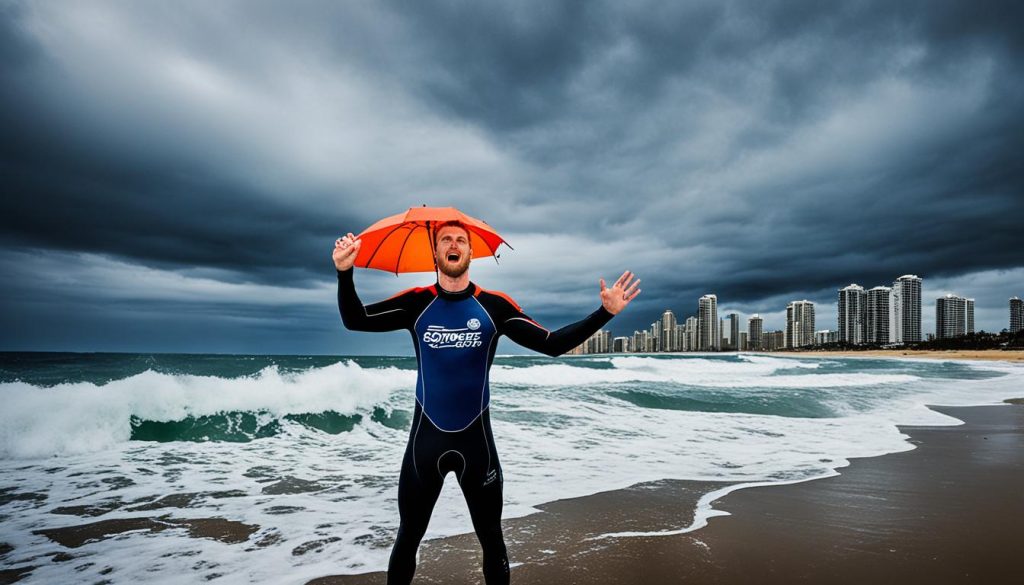
Preparation is key for a safe beach trip in Queensland’s north. Keep the stinger season in mind for a worry-free swim. Enjoy the beauty of the coast while staying safe.
Exploring the Outback: Best Times to Visit
Head into the heart of Australia’s rugged Outback, where Uluru and Kings Canyon are waiting. This desert region has a unique climate. It offers the best experience when you consider the seasonal weather patterns.
Beating the Heat: Ideal Months for Outback Adventures
The best time to visit the Outback is from April to October. During this period, the weather is more comfortable. This lets you enjoy the stunning landscapes without the summer heat.
The spring (September-November) and fall (March-May) seasons are great for adventures. These seasons have milder weather and beautiful scenery. You can see vibrant wildflowers or autumn foliage. Avoid the extreme heat of summer and enjoy the cooler, more pleasant conditions instead.
| Location | Ideal Travel Months | Average Temperatures |
|---|---|---|
| Uluru (Ayers Rock) | April – October | 68°F – 95°F |
| Kings Canyon | March – November | 59°F – 86°F |
| Alice Springs | April – October | 50°F – 86°F |
Plan your Outback trip during the ideal travel months. This way, you can see the rugged beauty of this amazing region. And you can avoid the extreme heat for the best experience.
Gold Coast, Queensland: Best Months for a Weather-Savvy Trip
Planning a trip to the Gold Coast in Queensland means thinking about the weather and crowds. This area has a warm, subtropical climate with little rain all year. It’s perfect for travelers who love good weather.
Balancing Ideal Weather and Crowd Levels
The summer months, from December to February, are the busiest in the Gold Coast. You’ll get hot, sunny days great for the beach, but expect big crowds and higher prices. For a quieter time, visit in spring (September to November) or fall (March to May).
Spring and fall bring temperatures from the 60s to mid-70s Fahrenheit. The humidity is lower, and there are fewer people. It’s the best time to see the beautiful coast, surf spots, and outdoor activities.
Seasonal Events and Festivals
The Gold Coast has many events and festivals all year. You can catch music festivals, art events, cultural happenings, and sports. Planning your visit around these can make it even more special.
Whether you want the best weather, fewer crowds, or to join in local celebrations, the Gold Coast has it all. It’s a great place for a memorable trip.
| Month | Average Temperature | Rainfall | Sunshine Hours |
|---|---|---|---|
| January | 77°F (25°C) | 1.2 inches | 14 hours |
| July | 59°F (15°C) | 0.4 inches | 10 hours |
| February | 80°F (27°C) | 1.7 inches | 13 hours |
| November | 72°F (22°C) | 1.1 inches | 11 hours |
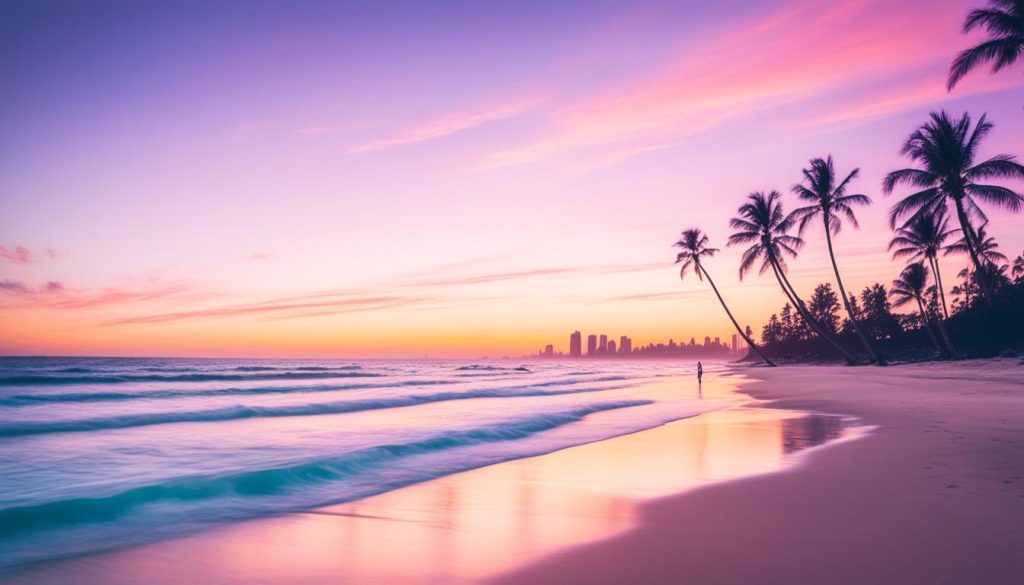
“The Gold Coast is a true year-round destination, but the shoulder seasons of spring and fall offer the best combination of ideal weather and fewer crowds.”
Planning Your Trip: Insider Tips
Planning your Gold Coast getaway requires some insider tips for a smooth trip. Make sure to book your accommodations and activities early, especially in peak seasons. The public transportation system of buses and trams is efficient, but a rental car gives you more freedom to explore. These tips will help you enjoy your time in this sunny, coastal paradise.
Here are more tips for planning your trip:
- Learn about the seasonal weather to pack right and avoid surprises.
- Look into local transportation like the free CityHopper ferry and buses to get around easily.
- Check out the varied dining and entertainment options, from beachside cafes to famous vineyards.
- Choose accommodations that fit your style and budget, from high-rise hotels to cozy beach cabins.
- Keep an eye on upcoming events and festivals to plan your visit around them.
Using these trip planning tips, you’re set for an unforgettable Gold Coast experience. Enjoy the beautiful beaches, lively culture, and endless chances for adventure and relaxation.
Queensland Tourism: Highlights and Attractions
Queensland, Australia, is a place full of diverse experiences for visitors. It has stunning Gold Coast beaches, vibrant cultural attractions, and exciting festivals and events. This tropical paradise has something for every kind of traveler.
Coastal Gems: Beaches, Surfing, and Water Activities
The Gold Coast has 53 kilometers of coastline with beaches great for swimming, sunbathing, and water sports. The Coolangatta-to-Snapper Rocks walk lets you see surfers at The Superbank, a top surfing spot. Coolangatta and Currumbin are great for bike rides and beach fun.
There’s more than the ocean. The Broadwater, north of Surfers Paradise, is calm and perfect for various activities. It also has ferry services to theme parks and places to eat. The Gold Coast Hinterland offers World-Heritage-listed parks and wineries, a peaceful break from the coast.
Cultural Experiences and Events
Queensland’s cultural attractions and festivals and events show the local culture. The Currumbin Wildlife Sanctuary is a family favorite, where you can meet many Australian animals.
Mount Tamborine’s Gallery Walk is perfect for art lovers, with galleries and beautiful views. The historic St Bernards Hotel near Mount Tamborine offers great food and views of the northern Gold Coast.
Queensland has beaches, water sports, and cultural experiences for everyone. From busy cities to the peaceful Outback, it’s full of natural and cultural wonders to explore.
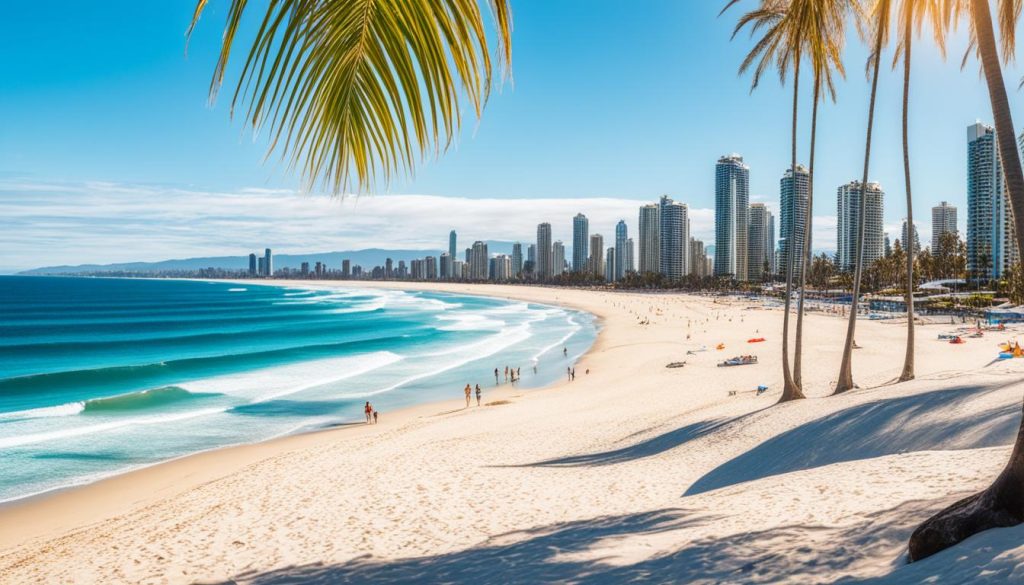
Undara Volcanic National Park: A Geological Marvel
In the heart of Queensland lies the Undara Volcanic National Park, a hidden treasure. It boasts some of the longest and largest lava tubes globally. These tubes stretch for 255 kilometers, inviting visitors to explore an ancient world beneath their feet.
Guided tours reveal the park’s basalt structures and cave systems. You’ll also learn about the microbats that call this place home. It’s like stepping back in time, marveling at the Earth’s power and resilience.
- Undara Volcanic National Park is home to some of the longest and largest lava tubes in the world, stretching an incredible 255 kilometers.
- Formed over 190,000 years ago by a massive volcanic eruption, these geological formations provide a glimpse into the Earth’s ancient past.
- Guided tours allow visitors to explore the basalt structures, cave systems, and the diverse wildlife, including the microbats that inhabit this natural wonder.
If you love geology or just appreciate nature’s power, don’t miss Undara Volcanic National Park. Dive into its history and marvel at the formations that have endured for millennia.
| Geological Formation | Length | Unique Features |
|---|---|---|
| Undara Lava Tubes | 255 kilometers | Longest lava tubes in the world, formed by a massive volcanic eruption 190,000 years ago |
| Basalt Structures | Varied | Captivating basalt formations, created by the cooling and solidification of lava |
| Cave Systems | Extensive | Intricate cave networks within the lava tubes, home to diverse wildlife like microbats |
“Undara Volcanic National Park is a true geological marvel, showcasing the incredible power and resilience of the Earth’s natural forces.”
Discover the Undara Volcanic National Park’s wonders. Immerse yourself in unique geological formations, ancient caves, and thriving wildlife. This natural wonder shows the lasting beauty and complexity of our planet.
Discovering the Great Barrier Reef
No trip to Queensland is complete without seeing the Great Barrier Reef. It’s the biggest living structure in the world. This natural wonder stretches over 344,400 square kilometers. It’s filled with a wide variety of marine life, making it a top spot for anyone visiting Queensland’s coast.
There are many ways to experience the reef’s beauty. You can snorkel or dive to see the colorful corals and marine creatures up close. Or, take a glass-bottom boat tour to see the underwater world without getting wet.
A two-night “Liveaboard” trip to the Great Barrier Reef costs about $400 AUD per person. A one-day trip is around $100 AUD. With a budget of $600 AUD, you can fully enjoy the reef and explore the Cairns area. This includes a trip to Kuranda Village by cable car and railway.
The best time to visit the Great Barrier Reef is from June to October. The weather is stable and perfect for outdoor activities during this period. But, the reef is beautiful all year, each season offering unique experiences.
Whether you want an exciting adventure or a relaxing trip, the Great Barrier Reef is a must-see. It will amaze you with its beauty and the variety of marine life.
| Activity | Cost (AUD) |
|---|---|
| Mid-range two-night “Liveaboard” trip to the Great Barrier Reef | $400 |
| One-day trip to the Great Barrier Reef | $100 |
| Realistic budget to enjoy the Great Barrier Reef and the Cairns experience | $600 |
| Cable car and scenic railway combination ticket to Kuranda Village (self-driving) | $112.50 |
| Cable car and scenic railway combination ticket to Kuranda Village (with transfers) | $126 |
| Trip to the Whitsundays | $59 |
| Paronella Park experiences | From $46 per adult |
Most tours to the Great Barrier Reef let you cancel for free within 24 hours and confirm right away. This makes planning your trip easy. Use websites like GetYourGuide, Viator, and TripAdvisor to find the best tour for your budget and needs.
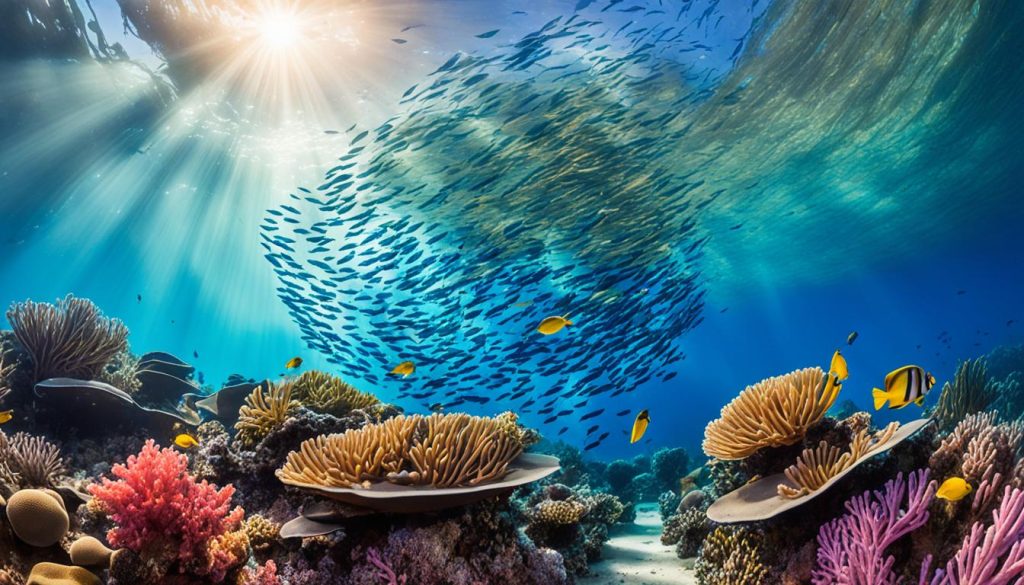
Fraser Island: The World's Largest Sand Island
Off the coast of Queensland, Australia, lies Fraser Island, also known as K’gari to the Butchulla people. It’s the world’s largest sand island, filled with attractions that draw visitors from everywhere. This place is a natural wonder.
Fraser Island is famous for its ancient rainforests that grow on sand. You can go on exciting 4WD tours to see the island’s wild beauty. You’ll find hidden rock pools and freshwater lakes, like the famous Lake McKenzie, which is one of the clearest in the world.
The best time to visit is from April to September. The weather is mild, perfect for outdoor fun. You can learn about the island’s culture, hike beautiful trails, and see whales from July to November.
| Activity | Best Time to Visit |
|---|---|
| 4WD Adventures | April to September |
| Cultural Exploration | April to September |
| Beach Relaxation | April to September |
| Wildlife Viewing | April to September |
| Hiking | April to September |
| Freshwater Lake Swims | April to September |
| Whale Watching | July to November |
| Fishing and Beachcombing | April to September |
Fraser Island has stunning beaches, ancient rainforests, and unique natural spots. It’s perfect for adventure, relaxation, or learning about the island’s culture. This place will leave a lasting impression on you.
“K’gari attracts a significant number of international visitors annually, and the recent name change to reflect its Indigenous heritage is a vital step towards respecting the Butchulla culture.”- Dr. Rose Barrowcliffe, Butchulla Postdoctoral Research Fellow
Conclusion
Planning your trip to the Gold Coast, Australia means thinking about the subtropical climate. This climate affects your vacation. Knowing the best times to visit helps you enjoy your trip more.
Whether you want sunny days for the beach or cooler weather for outdoor fun, the Gold Coast has it all. It’s full of natural and cultural sights to see.
With good planning and tips, your trip to this beautiful place will be unforgettable. You can see Minkie Whales in Cairns or go white water rafting on the Tully River. Queensland has something for everyone.
By picking the best times to visit, you’ll have a better time. You’ll make memories that last a lifetime in Queensland.
Queensland is known for its stunning beaches, lively culture, and breathtaking views. Plan your trip with the weather and crowds in mind. This way, you’ll have a smooth and unforgettable trip. You can dive into the beauty and culture of this magical place.
